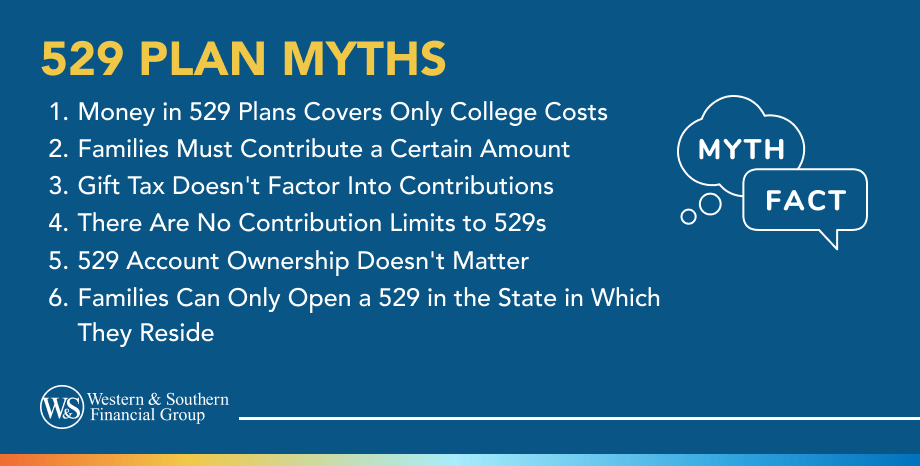

Key Takeaways
- Money in 529 plans can be used for more than just tuition, like room and board, textbooks, and laptops. But it cannot be used for non-qualified expenses without penalty.
- There is no required minimum contribution to open a 529 account. Many plans have low minimums to start.
- Contributions over $19,000 per year per recipient are subject to gift tax. The lifetime contribution limit varies by state, up to $550,000.
- 529 account ownership matters for tax purposes. The owner may be able to deduct contributions, but non-owners cannot.
- You don't have to open a 529 account in your state of residence. But be aware of any residency requirements for owners and beneficiaries of different state plans.
A 529 plan is a great way to start saving for your child's college education. While these plans offer many benefits — including the ability to set aside money that grows tax-deferred — several 529 college savings plan rules might leave you confused about the real pros and cons.
Let's debunk six common 529 plan myths so you can move forward with confidence as you save for your child's future.
Myth 1: Money in 529 Plans Covers Only College Costs
Tuition and fees are just one piece of the puzzle when paying for college. You can use money from a 529 education savings plan to pay for tuition. But the money can also go toward other qualified expenses, such as laptops and textbooks, as well as room and board. Just be sure to avoid putting 529 money toward nonqualified expenses such as gym fees or off-campus housing. You could be subject to a tax penalty if you misuse the money.
That said, keep in mind that there are two types of 529 plans. While a 529 education savings plan can be used to pay for tuition and qualified expenses, prepaid 529 plans can only be used to pay tuition, as they allow individuals to pay for future college education costs at the present-day rate.
Calculator
Use our College Savings Calculator to find out how much you may need to cover tuition, textbooks, room and board, and other qualified education expenses.
Myth 2: Families Must Contribute a Certain Amount
You needn't make a large initial deposit to open a 529 account. Many plans offer relatively low minimums of $250 or less, according to the U.S. Securities and Exchange Commission.1
Even if you start small, the sooner you begin saving, the more time your investment will have to potentially grow. Just keep in mind that investments cannot guarantee growth or sustainment of principal value; they may lose value over time. Past performance is not an indication of future results.
Myth 3: Gift Tax Doesn't Factor Into Contributions
Large financial gifts are subject to a federal gift tax. So, do you have to pay gift tax on what you put into a 529 account? The answer depends on how much you contribute.
Maximum Gift Amount
This maximum also applies to 529 plan contributions. Once you exceed $19,000 in contributions to a 529 account, the amount of your gift greater than $19,000 will be taxed to you (the giver). You'll want to keep this in mind if you're investing a large sum in a plan, whether at one time or over the year.
Myth 4: There Are No Contribution Limits to 529s
Unlike some types of investment accounts, there is no yearly cap on how much you can contribute to a 529 plan. However, there is a lifetime limit. The lifetime cap amount varies from state to state.3
State Maximum Contributions
Myth 5: 529 Account Ownership Doesn't Matter
If you open a 529 account for your child, you're the account owner and your child is the beneficiary. You ultimately control the account and decide how to invest and disburse the money. If someone else opens an account with your child as a beneficiary, they can eventually transfer ownership to you or your child to manage 529 withdrawals.
Account ownership can have important tax implications. In some states, the account owner is eligible to deduct 529 plan contributions on their tax return, but this benefit may not extend to nonowners who contribute to the plan. To clarify the 529 college savings plan rules and tax exemptions in your state, speak with a tax professional.
Myth 6: Families Can Only Open a 529 in the State in Which They Reside
Each state administers its own 529 plans, but it's possible to invest in a plan sponsored by a different state than where you live. It's important to note, though, that some 529 plans have residency requirements for owners and beneficiaries.4 So it's a good idea to meet with a financial professional who is knowledgeable in the rules of the state and make sure you understand the specifics of your plan.
Investing in a college savings plan can help decrease the financial burden of paying for college, but it's important to separate the 529 plan myths from the facts to ensure you're investing wisely and complying with tax laws. By working with a financial professional, you can start on the right foot as you save for education expenses.
Keep in mind, not all financial professionals are able to sell all plans. Be sure to ask if your financial professional can sell your state's plan or if they can only recommend an out-of-state plan for you.
A 529 plan helps college savings grow with flexibility and tax benefits. Invest Today
Frequently Asked Questions
What happens to a 529 if a kid never goes to college?
Can you roll a 529 into a Roth IRA?
What is the 5 year rule for 529 plans?
How does a 529 affect FAFSA?
Sources
- Investor bulletin: 10 questions to consider before opening a 529 account. https://www.investor.gov/introduction-investing/general-resources/news-alerts/alerts-bulletins/investor-bulletins-10.
- What's new — estate and gift tax. https://www.irs.gov/businesses/small-businesses-self-employed/whats-new-estate-and-gift-tax.
- Flynn K. Maximum 529 plan contribution limits by state. https://www.savingforcollege.com/article/maximum-529-plan-contribution-limits-by-state.
- An introduction to 529 plans. https://www.investor.gov/introduction-investing/general-resources/news-alerts/alerts-bulletins/investor-bulletins/updated-16.
- How to Make the 529 5 Year Election. https://accountinginsights.org/how-to-make-the-529-5-year-election/.



























